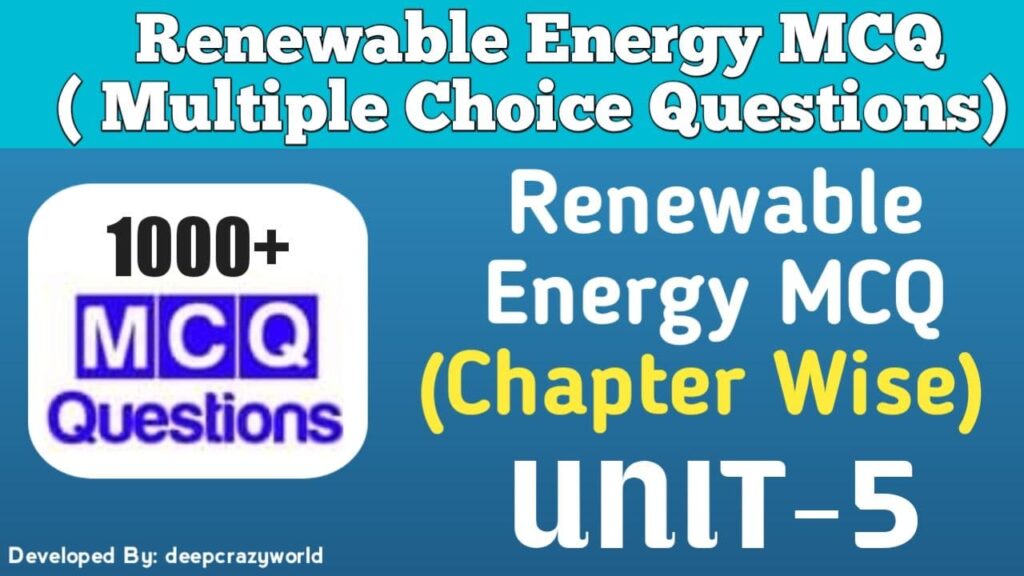Wind Energy Multiple Choice Questions & Answers focuses on Origin of Winds – 2 . Renewable Energy MCQ unit 5 – Here’s the list of chapters on the “Renewable Energy” subject covering 100+ topics. You can practice the Renewable Energy 1000+ MCQ questions chapter by chapter starting from the 1st chapter or you can jump to any chapter of your choice.
Renewable Energy Chapters
- Fundamentals of Energy
- Basics of Solar Energy
- Solar Thermal System
- Wind Energy
- Biomass Energy
- Geothermal Energy
- Ocean Energy
- Emerging Technologies
Biomass Energy UNIT – 5
The section contains questions and answers on solar radiation, photosynthesis process, biomass usable forms, composition and fuel properties, biomass resources and conversion technologies, biomass gasification and biogas production.
- Solar Radiation on Inclined Plane Surface
- Photosynthesis Process
- Usable Forms of Biomass, their Composition and Fuel Properties – 1
- Usable Forms of Biomass, their Composition and Fuel Properties – 2
- Biomass Resources
- Biomass Conversion Technologies – 1
- Biomass Conversion Technologies – 2
- Biomass Gasification – 1
- Biomass Gasification – 2
- Biogas Production from Waste Biomass

Biomass Energy Questions and Answers – Solar Radiation on Inclined Plane Surface
- When is the power density of the absorbing surface equal to the incident sunlight?
a) Absorbing surface and incident sunlight are perpendicular to each other
b) Absorbing surface and incident sunlight are parallel to each other
c) Absorbing surface and incident sunlight are inclined at an acute angle to each other
d) Absorbing surface and incident sunlight are inclined at an obtuse angle to each other
View Answer
Answer: d
Explanation: Net power received from incident sunlight depends on two things – the power contained in the sunlight and the angle of the receiver with respect to the incident sunlight. Incident power equals the received power when the receiver is perpendicular to the incident sunlight.
- For a fixed receiver, incident power density and received power density are always equal.
a) True
b) False
View Answer
Answer: b
Explanation: For a fixed receiver, incident power density and received power density are not equal always. In fact, the net received power is often less than the incident power as the angle between the sun and the receiver changes continuously.
- What is direct solar radiation?
a) Radiation scattered by molecules
b) Radiation reflected from an obstacle
c) Radiation traveling on a straight line from sun to earth
d) Sum of diffused and reflected radiation energies
View Answer
Answer: c
Explanation: Direct solar radiation is that radiation which travels in a straight line from the sun. It travels to the earth without deviating from its path due to obstacles.
- What is diffused solar radiation?
a) Sum of direct and reflected radiation energies
b) Radiation reflected from an obstacle
c) Radiation traveling on a straight line from sun to earth
d) Radiation scattered by molecules
View Answer
Answer: d
Explanation: Diffused solar radiation is that radiation which has been scattered by molecules and particles in atmosphere. Though it deviates from its initial path, it does travel down to the earth.
- Which of the following is tried to maximized in tilted receivers (panels)?
a) Direct radiation
b) Diffused radiation
c) Reflected radiation
d) Diffracted radiation
View Answer
Answer: a
Explanation: Receivers are tilted to maximize the collection of direct solar radiation from the sun. The tilt tries to ensure that the receivers are perpendicular to the direct radiation. It accounts for the continuous change in angle between the sun and the receiver.
- When receivers (panels) are laid horizontally, they usually collect _
a) Direct radiation
b) Diffused radiation
c) Deflected radiation
d) Heat
View Answer
Answer: b
Explanation: When solar receivers (panels) are laid horizontally, they usually collect diffused radiation. This is because diffused radiation is equally distributed throughout the sky and hence can easily be gathered.
- More the tilt in receivers (panels), larger amounts of diffused radiation is collected.
a) False
b) True
View Answer
Answer: a
Explanation: More the tilt in receivers, larger amounts of direct radiation is collected. As the tilt increases, the amount of diffused radiation received considerably reduces.
- What is reflected solar radiation?
a) Sum of direct and reflected radiation energies
b) Radiation reflected from an atmospheric obstacle
c) Radiation traveling on a straight line from sun to earth
d) Radiation reflected from a non-atmospheric obstacle
View Answer
Answer: d
Explanation: Reflected solar radiation is that sunlight/radiation that is reflected from a non-atmospheric obstacle. The obstacles could be trees, ground, light poles, cars, etc. They do not contribute significantly towards electricity generation from solar panels.
- Reflected solar radiation is used in _
a) Snowy regions
b) Temperate region
c) Equatorial region
d) Tropical region
View Answer
Answer: a
Explanation: Generally, reflected solar radiation does contribute significantly towards electricity generation. However, energy from reflected radiation is harvested in snowy regions as fresh snow reflects about 80-90% of the incident radiation.
- What is global insolation?
a) Direct radiation + diffused radiation
b) Diffused radiation – direct radiation
c) Direct radiation + diffused radiation + reflected radiation
d) Reflected radiation * direct radiation
View Answer
Answer: c
Explanation: Global insolation or total insolation is the sum of the radiation received by earth from sun. It is nothing but the sum of direct radiation, diffused radiation and reflected radiation. This is used as a reference for the insolation at some tilt.
- What is normal radiation?
a) Direct radiation
b) Sun’s radiation and striking surface are perpendicular to each other
c) Incident solar radiation and striking surface are perpendicular to each other
d) Global insolation – direct radiation
View Answer
Answer: b
Explanation: Normal radiation describes the radiation that strikes a surface that is perpendicular to the sun’s radiation. It is not same as direct radiation as the it does not talk about the incident radiation. It may so happen that normal radiation and direct radiation may be the same at some tilt.
- What is hour angle of the sun?
a) Angle of radiation with earth’s surface
b) Angle between the hands of sun dial
c) Angle made by the sun’s rays with moon’s surface
d) Orientation of earth with respect to sun
View Answer
Answer: d
Explanation: Hour angle of sun is defined as the actual orientation of earth with respect to the sun. Mathematically, it is calculated by converting earth’s one rotation in degrees and dividing it by the time taken – 360/24 = 15 degrees/h.
- What is solar intensity?
a) Amount of outgoing solar energy
b) Amount of incoming solar energy on a plane surface
c) Amount of outgoing solar energy on a plane surface per unit time
d) Amount of incoming solar energy on a plane surface per unit time per unit area
View Answer
Answer: d
Explanation: Solar intensity is defined as the amount of incoming solar energy on a plane surface per unit time per unit area. It is a weighted average of the full radiation and is equal to 1367 Watt/square meter.
- What is solar azimuth angle?
a) Orientation of earth with respect to sun
b) Orientation of moon with respect to sun
c) Angle of radiation with earth’s surface
d) Angular distance between zero azimuth and sun’s projection on ground
View Answer
Answer: d
Explanation: Solar azimuth angle is defined as the angular distance between zero azimuth and the projection of the line of sight to sun on the ground. Zero azimuth is a line due north or due south. Azimuth angle is measured clockwise from zero azimuth.
- Diffuse radiation models can be classified into and __
a) direct and reflective
b) adiabatic and isotropic
c) isotropic and anisotropic
d) anisotropic and adiabatic
View Answer
Answer: c
Explanation: Diffuse radiation models can be classified into isotropic and anisotropic. Isotropic models of diffuse radiation model diffuse radiation intensity by assuming uniform distribution throughout the sky (medium). Anisotropic models include suitable modules that are used to represent regions of increased (varied) diffuse radiation.
Biomass Energy Questions and Answers – Photosynthesis Process
- What is photosynthesis?
a) Plants generating carbohydrates and oxygen from carbon dioxide, water and sunlight using chlorophyll
b) Algae generating carbohydrates and oxygen from carbon dioxide, water and sunlight using chlorophyll
c) Cyanobacteria generating carbohydrates and oxygen from carbon dioxide, water and sunlight using chlorophyll
d) Photoautotroph generating carbohydrates and oxygen from carbon dioxide, water and sunlight
View Answer
Answer: d
Explanation: Photosynthesis is the process by which photoautotrophs generate food for themselves. They use carbon dioxide, water and sunlight to generate carbohydrates and oxygen. Photo means light.
- What is the primary product of photosynthesis?
a) Glucose
b) Oxygen
c) Water
d) Carbon dioxide
View Answer
Answer: a
Explanation: The primary product of photosynthesis is glucose. Oxygen is the by product. Water and carbon dioxide are the reactants.
- Which of the following best indicates photosynthesis?
a) Carbon dioxide + water → oxygen + glucose
b) 6CO2 + 6H2O → C6H12O6 + 6O2 (in the presence of sunlight)
c) Carbon dioxide + water → glucose + oxygen (in the presence of sunlight)
d) Oxygen + glucose → carbon dioxide + water
View Answer
Answer: b
Explanation: Photosynthesis occurs in the presence of sunlight. The balanced reaction of photosynthesis best describes the process of photosynthesis. The option with oxygen and glucose as reactants is not photosynthesis.
- Which of the following organisms can perform photosynthesis?
a) Autotrophs
b) Algae
c) Photoautotrophs
d) Plants
View Answer
Answer: c
Explanation: Photoautotrophs are organisms that perform photosynthesis to produce food for themselves. Algae and plants come under the category of photoautotrophs. All autotrophs are not necessarily photoautotrophs.
- Which of the following are photoautotrophs?
a) Cyanobacteria, algae, plants
b) Archaebacteria
c) Deer
d) Tiger
View Answer
Answer: a
Explanation: Cyanobacteria, algae and plants are photoautotrophs. Archaebacteria are chemoautotrophs. Deer and tiger are not autotrophs as they do not create their own food.
- Conversion of usable sunlight energy into chemical energy is associated with _
a) Red pigmentation
b) Green pigmentation
c) Orange pigmentation
d) Fruits
View Answer
Answer: b
Explanation: Conversion of usable sunlight energy into chemical energy is associated with green pigmentation. This green pigmentation is called chlorophyll. Plants and algae consist of chlorophyll which is a key ingredient for photosynthesis.
- Cyanobacteria have chloroplasts.
a) True
b) False
View Answer
Answer: b
Explanation: Though cyanobacteria are photoautotrophs, they do not have chloroplasts. Instead, the chlorophyll is stored in thylakoids in their cytoplasm.
- and is present in all chlorophylls.
a) A hydrophilic tail, a lipid soluble head
b) A hydrophobic tail, a lipid soluble head
c) A hydrophilic tail, a lipid insoluble head
d) A lipid soluble tail, a hydrophilic head
View Answer
Answer: d
Explanation: A lipid soluble tail and a hydrophilic head is present in all chlorophylls. The tail is a lipid soluble hydrocarbon and the hydrophilic head consists of magnesium ion at its centre.
- What type of chemical reactions are involved in photosynthesis?
a) Condensation reactions and redox reactions
b) Combustion
c) Double displacement
d) Single displacement
View Answer
Answer: a
Explanation: The chemical reactions involved in photosynthesis are condensation reactions and redox reactions respectively. Combustion, single and double displacement reactions do not occur in photosynthesis.
- What is the condensation reaction responsible for in the process of photosynthesis?
a) Electron transfer
b) Splitting out water molecules
c) Splitting out water molecules and phosphorylation
d) Electron transfer and phosphorylation
View Answer
Answer: c
Explanation: Condensation reaction is responsible for splitting out water molecules and phosphorylation. Phosphorylation is the addition of a phosphate group to an organic compound. Electron transfer occurs in a redox reaction.
- Where does the light-dependent reactions in the process of photosynthesis occur?
a) Stroma of chloroplasts
b) Thylakoid of chloroplasts
c) Inner membranes
d) Grana of chloroplasts
View Answer
Answer: d
Explanation: The light-dependent reactions in the process of photosynthesis occur in the grana of chloroplasts. These reactions require the light energy to make energy-carrier molecules that are used further.
- Where does the light-independent reactions in the process of photosynthesis occur?
a) Stroma of chloroplasts
b) Thylakoid of chloroplasts
c) Outer membranes
d) Grana of chloroplasts
View Answer
Answer: a
Explanation: The light-independent reactions in the process of photosynthesis occur in the stroma of chloroplasts. The products of light reaction are used to make carbohydrates from carbon dioxide.
- What is photoionisation? Assume presence of sunlight.
a) Freeing of electron from the molecule to form a negatively charged chlorophyll ion
b) Freeing of photoexcited electron from the molecule to form a positively charged chlorophyll ion
c) Absorbing of electron from the molecule to form a negatively charged chlorophyll ion
d) Absorbing of electron from the molecule to form a positively charged chlorophyll ion
View Answer
Answer: b
Explanation: Electrons of chlorophyll molecule gain energy and move to higher energy level when light is absorbed. On gaining sufficiently high energy, the electron leaves the molecule thereby forming a positively charged chlorophyll ion. This process is called photoionisation.
- Where does the energy to drive the electron transfer system come from?
a) Photosystem 1
b) Photosystem 3 and photosystem 2
c) Photosystem 1 and photosystem 2
d) Photosystem 1 and photosystem 3
View Answer
Answer: c
Explanation: An electron transfer system (basically, a series of chemical reactions) carries two electrons to and fro across the thylakoid membrane. The energy for the system comes from photosystem 1 and photosystem 2.
- Which of the following are products of light-dependent reactions?
a) ATP and glyceraldehyde 3-phosphate
b) Glyceraldehyde 3-phosphate and NADPH
c) Carbohydrates
d) ATP and NADPH
View Answer
Answer: c
Explanation: The light-dependent reactions require direct energy of sunlight. They are a series of chemical reactions forming ATP and NADPH. These products are further used by light-independent reactions to produce carbohydrates.
Renewable Energy Mcq, Renewable Energy Multiple Choice Questions and answer, Renewable Energy Multiple Choice Questions mcq renewable and nonrenewable resources multiple choice questions,multiple choice questions on renewable energy,renewable energy resources mcq,renewable energy resources mcq question and answers aktu,energy multiple choice questions and answers,mcq on renewable energy resources,renewable energy sources,quiz questions on renewable energy resources,solar cell multiple choice questions,renewable energy mcq questions and answers pdf,renewable energy sources mcq,renewable energy mcq sources mcq pdf,Renewable Energy mcq questions unit iwse
Renewable Energy MCQ UNIT -1
Renewable Energy MCQ UNIT -2
Renewable Energy MCQ UNIT -3
Renewable Energy MCQ UNIT -4
Renewable Energy MCQ UNIT -6
READ MORE…
If you found this post useful, don’t forget to share this with your friends, and if you have any query feel free to comment it in the comment section.
Thank you 🙂 Keep Learning !


